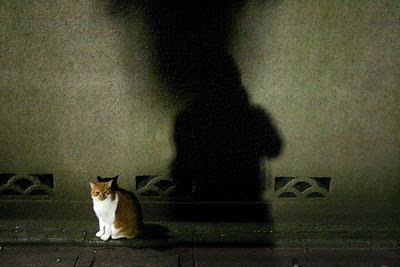雨遁 Uton no Jutsu: a Rainy Day Escape.
From Bujinkan Santa Monica by Bujinkan Santa Monica
 |
| photo by J.J. Verhoef |
Out of the 30 methods of escaping, let's look at one that is contained in the tenton juppo section: 雨遁 Uton no jutsu (Rain Evasion). Using the elements of weather to aid in escape and evasion is a very natural technique, but that same weather can work against you. The trick is to be in harmony with nature's laws. As Hatsumi Sensei says, "... everywhere in the world, the trees are growing towards the sky and the rain falls towards the ground." Bearing this in mind, remember that Soke has also stated that modern military stealth methods may supersede the old densho and that we should keep up with the times. But there is still much to learn in our tradition.
To begin to use the rain, it helps to know if it is coming. Forecasting is an old and honored tradition, one that is sometimes filled with pseudoscience but will work when paired with observation skills. This is what is known as tenmon. Soke says that in the old days people observed closely the natural cycles:
"they studied the animals and plants and found ways to make predictions. For example, if sparrows enter the thicket or stay high up in their trees after busily eating food, or if insects start to enter buildings, or carp jump out of the water, or frogs start to croak, it is a premonition that rain is going to fall."Of course modern weather forecasting and meteorology gives us some advantage, but there is still no substitute to sticking your head out the window or being in tune with the weather patterns of your region. Sensei says it is "natural to be alert."
Here's what the National Geospatial-Intelligence Agency says about a product they designed for evasion and survival:
"When Air Force Captain Scott O'Grady was shot down over Bosnia during June 1995, one of the items he acknowledged that assisted in his survival was the Evasion Chart (EVC) he carried in his vest pocket. In addition to using the chart to pinpoint his exact location, he used this unique product in a seemingly unusual way, but in fact one way that it was designed for--as a protection against the elements. Sized specifically to fit in aircrew flight suit pocket, the EVC can be used:To catch rain for drinking water; As a shade from wind and rain, and as a shelter, cape and blanket; As a bag to haul and purify large quantities of water or food; As a liner in a hole to serve as a wash basin; As ground cloth on moist ground, or as camouflage when sleeping; To wrap clothing in when swimming or fording streams; To wrap torso with as an extra layer of clothing; To wrap sleeping gear in it during foul weather; To splint a broken wrist..."Once the rain starts, we can use it in many ways, practical and mysterious.
- The sound of the rain can mask the noise of your movement. Even the soggy leaves and twigs become quiet when we step on them. Be careful of splashing and slipping!
- People tend to stay inside and off the streets. The rain can cause patrols to change. Guards are maybe not as alert while they try to keep dry. Some may abandon their normal posts to seek refuge indoors. Of course, that means you are also getting wet. Your gear and clothing may not function as well. And your stamina or immune system may become weakened.
- Rain can be caught for drinking. This may make you lighter if you don't have to carry your own water, or just save your butt if you didn't have any. But rain does make your clothing and gear heavier.
- Rain affects vision. Visibility decreases and at night and heavy rain reflects light back to it's source, creating a blinding effect. Umbrellas are also useful cover against cameras and being identified.
- Another aspect of rain is that it changes geography. Large puddles or flooding washes make areas inaccessible or impassible. This creates opportunity for evasion or escape into areas where you will not be pursued. Don't drown or get trapped!
Observing how rain and water itself falls, or human and animal behavior in the rain gives many lessons for evasion. Sensei says that rain takes on different aspects and a Ninja makes use of each phase.
"Rain becomes water vapor, rises into the skies, turns into clouds, and then becomes rain again, or a heat haze. Turning and turning, it is in a perpetual, cyclical motion."Being rained on by the 幸雲 Cloud of Happiness (Good Fortune)
Hatsumi Sensei says that "one can perform uton no jutsu using cigarette smoke." and "If a ninja detected a stimulus from the outside world, no matter how slight, they would respond immediately."
Soke describes this feeling of gokui as that of being a jellyfish floating in the ocean. And he says that,
Takamatsu Sensei used to call himself senile and then drift about in the air of Kashiwara City, drawing and painting, and finding joy in it. This is to drift and feel the existence of the world, empathize with flowers and enjoy the harmony, and to reach heaven as a live human being."Perhaps like smoke rising among raindrops.



